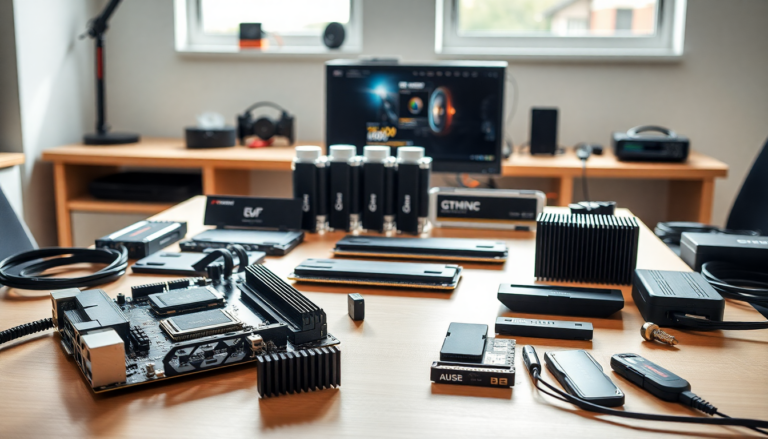Argomenti trattati
Crafting your ideal 1080p gaming PC doesn’t have to be overwhelming or expensive. With a strategic selection of components, you can create a powerful setup that delivers an impressive gaming experience without breaking the bank. The key is to find a balance between performance and budget, ensuring you get the most out of your investment. In this guide, we’ll dive into the essential parts you need, from the CPU and GPU to RAM and storage, all while keeping an eye on affordability and performance.
Choosing the right CPU for 1080p gaming
When selecting a CPU for your 1080p gaming rig, it’s crucial to strike the right balance between price and performance. Mid-range processors such as the Ryzen 7 5700G or the Intel Core i5-13400 are excellent choices, offering sufficient power to handle most modern games at high settings. These processors typically feature 6 to 8 cores, which is more than adequate for gaming, and their clock speeds between 3.5 GHz to 4.0 GHz ensure smooth gameplay.
Keep in mind that you don’t need the most expensive CPU on the market to achieve great performance. For example, the Core i7-14700K provides an impressive 97% of the flagship i9’s performance while being more budget-friendly. This strategic selection allows you to allocate more funds to your GPU, which is equally vital for gaming. If you’re on a tighter budget, the Core i5-13400 offers integrated graphics, making it a fantastic option for those looking to save a bit more.
Finding the perfect graphics card
Your GPU is arguably the most crucial component when building a 1080p gaming PC. It determines how well your games will perform visually. With an array of options available, it’s essential to choose wisely. The RTX 4060 is a standout choice, delivering excellent performance and future-proofing your system without a hefty price tag. It excels in modern titles and includes features like ray tracing and DLSS 3, which can significantly enhance your gaming experience.
If you’re looking for budget options, consider the AMD RX 7600, which consistently delivers over 60fps in demanding games. Alternatively, Intel’s Arc A750 provides impressive performance at a lower cost but requires regular driver updates for optimal performance. The RTX 3050 is another viable option, especially for ultra-budget builds, offering decent performance at a wallet-friendly price, though it may require some settings adjustments in newer titles.
Memory and storage considerations
For a smooth 1080p gaming experience, starting with at least 16GB of RAM is advisable. Opt for a DDR4-3600 kit to ensure speed and reliability. Brands like Team Xtreem ARGB are notable for their performance. Moreover, consider enabling XMP profiles in your BIOS to maximize RAM speeds. As for storage, a fast NVMe SSD will significantly improve load times and overall system responsiveness. Pair it with a larger HDD for your game library to balance speed with capacity.
Avoid mixing RAM kits as it can lead to instability and performance issues. Always aim for dual-channel mode to maximize performance. While DDR5 is becoming popular, for 1080p gaming, DDR4 provides the best value for your money.
Power supply and cooling solutions
Choosing the right power supply unit (PSU) is vital for your gaming setup. Aim for a PSU rated between 450W and 600W, ensuring it has an 80 Plus certification for efficiency. A quality PSU not only powers your components reliably but also allows for potential future upgrades. If you’re planning to run high-end graphics cards or even dual GPUs, consider a PSU of at least 750W to ensure stability.
Cooling is another critical aspect of your build. While air cooling may be sufficient for most users, liquid cooling systems can offer superior performance and quieter operation, especially if you plan to overclock. Options like the be quiet! Shadow Base 800 FX provide excellent cooling capabilities without significant noise, making them ideal for any gaming rig.
Putting it all together
After selecting your components, it’s time to assemble your gaming PC. Start by preparing your case, ensuring it can accommodate your motherboard and all components comfortably. Carefully install the CPU and cooling solution first, followed by the RAM and storage drives. Finally, secure your GPU into the PCIe slot. Be patient and meticulous during this process; taking your time will lead to a smoother setup and better performance overall.
Once your rig is assembled, boot it up and enter the BIOS to configure your settings. Make sure to enable XMP for your RAM and ensure that everything is recognized correctly. After that, install your operating system and drivers, and you’re ready to start gaming!
Building a 1080p gaming PC is an exciting journey that can yield fantastic results. With the right components and a little patience, you’ll create a powerful machine that runs modern games beautifully. So, gather your parts, roll up your sleeves, and dive into the world of PC gaming. You’re on the brink of an incredible gaming experience!

